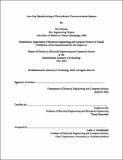Low-Cost Manufacturing of Electrokinetic Preconcentration Systems
Author(s)
Wynne, Eric
DownloadThesis PDF (2.850Mb)
Advisor
Han, Jongyoon
Terms of use
Metadata
Show full item recordAbstract
Detection of low-abundance biomolecules is a critical challenge in improving the safety and efficacy of pharmaceuticals. The methods and technologies for detecting DNA, RNA, and proteins have increased in sensitivity such that even single copies can be detected in certain conditions. However, due to diffusion limited transport of the biomolecules to sensors, these emerging biosensing technologies are only able to process a very small fraction of sample volume available. Therefore, there is a need for technology that can reduce the sampling error by concentrating the relevant molecules into a volume compatible with the sensing technology.
Here we present a low-cost, manufacturable implementation of a sample preconcentration device that uses the ion concentration polarization phenomena to filter charged biomolecules from a solution. Compared to previous electrokinetic concentrators, our device prioritizes manufacturability and sample throughput so that there is a simple path to deploying the device in the biological labs and even field-based detection in the future. We demonstrate the stabilizing effect of microscale fluidic features in electrokinetic concentrators by characterizing device performance with various feature dimensions. We also characterize the preconcentration performance as a function of the applied voltage and the pressure-driven flow velocity. Finally, we explore alternate device designs made possible by our low-cost manufacturing methods and materials, to provide a guide for future improvements. Ultimately, our work demonstrates a novel fabrication method that could be generalized to other devices and bring electrokinetic concentrators closer to broader adoption outside of the microfluidics research community.
Date issued
2022-05Department
Massachusetts Institute of Technology. Department of Electrical Engineering and Computer SciencePublisher
Massachusetts Institute of Technology